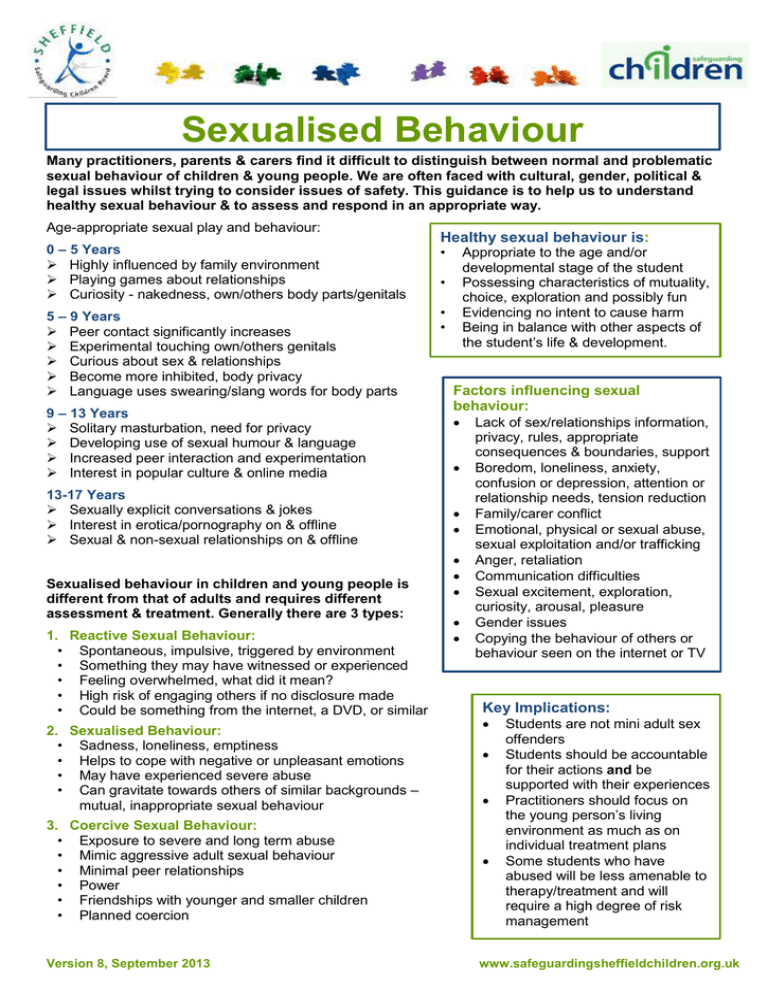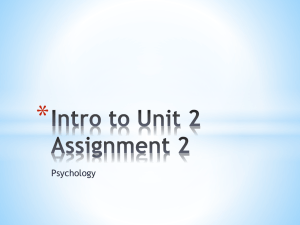
Sexualised Behaviour
Many practitioners, parents & carers find it difficult to distinguish between normal and problematic
sexual behaviour of children & young people. We are often faced with cultural, gender, political &
legal issues whilst trying to consider issues of safety. This guidance is to help us to understand
healthy sexual behaviour & to assess and respond in an appropriate way.
Age-appropriate sexual play and behaviour:
0 – 5 Years
Highly influenced by family environment
Playing games about relationships
Curiosity - nakedness, own/others body parts/genitals
5 – 9 Years
Peer contact significantly increases
Experimental touching own/others genitals
Curious about sex & relationships
Become more inhibited, body privacy
Language uses swearing/slang words for body parts
9 – 13 Years
Solitary masturbation, need for privacy
Developing use of sexual humour & language
Increased peer interaction and experimentation
Interest in popular culture & online media
13-17 Years
Sexually explicit conversations & jokes
Interest in erotica/pornography on & offline
Sexual & non-sexual relationships on & offline
Sexualised behaviour in children and young people is
different from that of adults and requires different
assessment & treatment. Generally there are 3 types:
1. Reactive Sexual Behaviour:
• Spontaneous, impulsive, triggered by environment
• Something they may have witnessed or experienced
• Feeling overwhelmed, what did it mean?
• High risk of engaging others if no disclosure made
• Could be something from the internet, a DVD, or similar
2. Sexualised Behaviour:
• Sadness, loneliness, emptiness
• Helps to cope with negative or unpleasant emotions
• May have experienced severe abuse
• Can gravitate towards others of similar backgrounds –
mutual, inappropriate sexual behaviour
3. Coercive Sexual Behaviour:
• Exposure to severe and long term abuse
• Mimic aggressive adult sexual behaviour
• Minimal peer relationships
• Power
• Friendships with younger and smaller children
• Planned coercion
Version 8, September 2013
Healthy sexual behaviour is:
•
•
•
•
Appropriate to the age and/or
developmental stage of the student
Possessing characteristics of mutuality,
choice, exploration and possibly fun
Evidencing no intent to cause harm
Being in balance with other aspects of
the student’s life & development.
Factors influencing sexual
behaviour:
Lack of sex/relationships information,
privacy, rules, appropriate
consequences & boundaries, support
Boredom, loneliness, anxiety,
confusion or depression, attention or
relationship needs, tension reduction
Family/carer conflict
Emotional, physical or sexual abuse,
sexual exploitation and/or trafficking
Anger, retaliation
Communication difficulties
Sexual excitement, exploration,
curiosity, arousal, pleasure
Gender issues
Copying the behaviour of others or
behaviour seen on the internet or TV
Key Implications:
Students are not mini adult sex
offenders
Students should be accountable
for their actions and be
supported with their experiences
Practitioners should focus on
the young person’s living
environment as much as on
individual treatment plans
Some students who have
abused will be less amenable to
therapy/treatment and will
require a high degree of risk
management
www.safeguardingsheffieldchildren.org.uk
Masturbation is one of the most common sexualised behaviour found in schools.
Staff may first want to mention their observation of any frequent masturbation to the child or young person’s
parents, as there may be a medical association, for example a rash.
Follow steps above & consider strategies:
‘Cueing’: agree a simple word or visual cue that you can say or show when the child or young person is
engaging in masturbation
‘Redirection’: take notice of when the behaviour occurs & provide an alternative activity or distraction
‘Positive reinforcement’: use a chart or visual
Steps:
reinforcement when the child is behaving
appropriately, e.g. star charts or ‘thumbs up’.
1. Always communicate concerns in a calm,
GREEN Light Behaviour is safe and healthy
sexual development which is:
Displayed between children or young people
of similar age or developmental ability
Reflects curiosity, experimentation,
consensual activities and positive choices
Is ‘normal’ but inappropriate within the
school/classroom setting
Action:
Follow steps 1-7
Reassure parents & student there is no
‘cause for concern’ or need for further
discipline
Ask parents to reinforce ‘message’ at home
clear, non-judgemental, factual way
2. Describe the behaviour, say how you felt, how
others might feel, what is ‘appropriate’
3. Enforce that that the behaviour should not reoccur or escalate
4. Consider preventative rules and boundaries
5. If another student was the focus:
a. reassure them that it was not their fault
b. tell them to inform an adult if repeated
c. discuss their support needs
d. tell them you will inform their parents
e. consider their need for confidentiality
6. Record behaviour to track issues & incidents
(for both students)
AMBER Light Behaviour is potentially outside
safe and healthy development due to:
Age or developmental differences
Activity type, frequency, duration or context
Action:
Inform Lead/Deputy Child Protection Liaison
Teacher/Officer (CPLT/O) immediately
Follow Steps 1 to 9
Meet parents and discuss the school
procedure for responding to the behaviour,
where the behaviour may have come from &
that this does not necessarily mean their child
has been abused
RED Light Behaviour is clearly outside safe and
healthy development and:
Involves much more coerciveness, secrecy,
compulsiveness & threats
Requires action from school & other agencies
Action:
Inform Lead/Deputy Child Protection Liaison
Teacher/Officer (CPLT/O) immediately
Follow Steps 1 to 10
Do not meet with parents until step 8 is
completed
Version 8, September 2013
7. Monitor, observe & support the student and:
a. interactions with other students
b. offer opportunities to talk about impact of
behaviour, feelings, friendships, interests
& activities
c. encourage student to develop an internal
motivation to stop
d. consider restrictions and rules including
secluding student for own & other’s safety
8. Discuss with Head Teacher and/or CPLT/O,
decide if it’s appropriate to meet & discuss
with parents & who will do this promptly
9. CPLT/O will:
a. consider a Common Assessment with
parents/carers to discuss wider issues
b. draw up a safety plan for school
c. consider involving other agencies
including Children’s Social Care
d. arrange a CAF multi-agency meeting to
discuss support needs of family
10. CPLT/O will refer to Children’s Social Care
before further/discussion with parents in
order to discuss risk of significant harm to
child and potential police investigation
www.safeguardingsheffieldchildren.org.uk




